Guide To Simulating ALMA Data
UNDER CONSTRUCTION
This guide is applicable to CASA version 4.1.
Introduction: Why Simulate ALMA Observations?
Observations made with radio interferometers can be tricky to interpret and analyze. Interferometers, by their nature, do not sample all spatial frequencies on the sky. In other words, they are not sensitive to diffuse emission, and depending on a number of factors including the configuration of the individual antennas, the length of the observation, and the location of the target source on the sky, an interferometric observation will be insensitive to structure on various different spatial scales. Observers therefore must use caution when interpreting interferometric images.
Plots of "uv coverage" are often used to demonstrate the range of spatial frequencies measured by a specific interferometric observation. The uv coverage plot can be thought of as a mask that is applied to the fourier distribution of the emission pattern on the sky. More densely sampled uv space leads to better images because the observation is more sensitive to a wider range of spatial frequencies on the sky.
To aid in interpreting their data, observers may find it helpful to simulate an interferometric observation using a variety of antenna configurations and different models of the sky brightness distribution. Simulations can also be a powerful tool to help new users understand both the power and the limitations of interferometric observations.
In some cases, those proposing to use ALMA may wish to simulate observations to bolster their ALMA proposal. For example, simulations can demonstrate the ability to resolve certain structures, and they can be used to justify the inclusion of compact or total power antennas.
Include Juergen's plot here.
Simulation Tools for Observers
There are several tools available on the web to help observers understand interferometric data and simulate observations. For example, those new to interferometry can get a basic understanding of how antenna placement affects uv coverage, the synthesized beam (i.e. the "resolution"), and the range of spatial sensitivities by exploring the "virtual radio interferometer":
http://www.narrabri.atnf.csiro.au/astronomy/vri.html
This is an interactive java application that allows one to simulate basic observations with MERLIN, ATCA, or WSRT, or ASKAP. The user can select from a few sample, idealized sky brightness patterns (e.g. a narrow gaussian) or use real sky brightness patterns, then fiddle interactively with the placement of antennas and the duration of the observation to see the effects of uv coverage on observations.
The OST
ALMA observers have two powerful simulation tools available: the Observation Support Tool (OST) [1], and the CASA simulation tool. The OST, which is hosted by the University of Manchester, is a web interface to the CASA simulation tool.
Like simobserve, the OST is based on the CASA sm toolkit. However, the OST and simobserve use different wrapper scripts and employ different treatment of atmospheric effects. Comparisons to the ALMA sensitivity calculator made in March 2011 suggest that both simobserve and the OST give similar noise level for observations in bands 3 through 8. However, the results of the two tools diverge in bands 9 and 10.
CASA simulation tools
There are two main tasks for simulating observations in CASA: simobserve and simanalyze. Starting with a model of sky brightness, simobserve generates the visibilities that would be measured with a telescope such as ALMA, the VLA, CARMA, SMA, ATCA, or PdB. The simobserve task can add thermal noise to the visibilities. The simobserve task uses the aatm atmospheric model (based on Juan Pardo's ATM library) to simulate real observing conditions and introduce atmospheric "corruption", i.e. noise and phase delay.
Next, the task simanalyze will produce a cleaned image based on the generated visibilities. It can compare the simulated image with your input (convolved with the output clean beam) and then calculate a "fidelity image" that indicates how well the simulated output matches the convolved input image.
Both simobserve and simanalyze can be broken down into a number of steps. The major steps are:
- simobserve
- Modify Model - If desired, you can scale the spatial coordinates, spectral axis, and brightness of the sky model image to simulate a specific type of observation. (For example, if you start with a model of M100 you might wish to scale the axes to simulate an observation of an M100-like galaxy that is 4X more distant.)
- Set Pointings - If your simulation contains multiple pointings in a mosaic, calculate the positions of individual pointings. These are saved in a text file. (You could also make such a text file yourself.)
- Predict - Calculate the visibilities. You will specify a telescope, antenna configuration, and date for the simulated observation.
- Corrupt - Next, "corrupt" the data, for example by introducing with thermal noise or phase noise.
- simanalyze
- Image - Image the visibility data with CASA's clean task.
- Analyze - Calculate and display the difference between output and input, and the fidelity image.
The Simulation Guide for New Users tutorial introduces and explains the individual steps in detail. It is possible to run the steps independently and optionally, as long as you follow the simobserve and simanalyze conventions about filenames.
Taskname History
The simulation tasks have been under significant revision and development.
- In CASA 3.3 simobserve and simanalyze were named sim_observe and sim_analyze, respectively.
- In CASA 3.4 and earlier, the functionality of both tasks was contained in task simdata, which is now obsolete.
- In CASA 4.1, a new experimental task simalma has been introduced, which simplifies simulation of 12m interferometric + 7m interferometric + total power ALMA observations. Please report any issue with simalma, and check back here for an upcoming simalma casaguide.
Values from simobserve or the OST should not be used to calculate exposure times for ALMA Science Goals. Only values from the ALMA sensitivity calculator should be used for this purpose, as it is the ALMA sensitivity calculator that will be used in the technical assessment of ALMA proposals. However, the results of simulations may be helpful to support a request for more observing time than is required by the sensitivity calculator, in order to obtain better uv-plane coverage.
Tutorials
| Simulation Guide for New Users (CASA 4.1) | 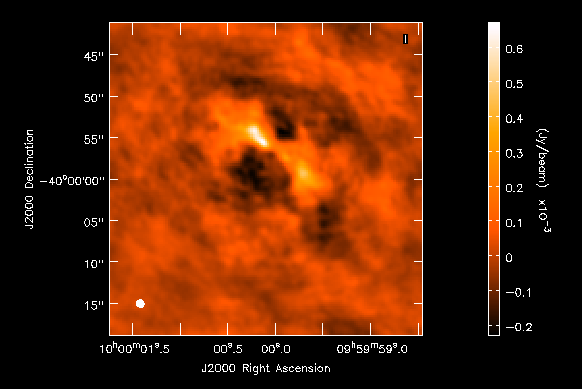
|
|---|---|
| A fully annotated tutorial that uses a Spitzer SAGE 8 micron continuum image of 30 Doradus and scales it to greater distance. A good place for new users to start. | |
| Protoplanetary Disk Simulation (CASA 4.1) | 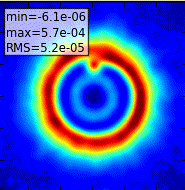
|
| A sky model with a lightly annotated script that simulates a protoplanetary disk. Uses a theoretical model of dust continuum from Sebastian Wolff, scaled to the distance of a nearby star. This is another fairly generic simulation - if you're short on time, you probably don't need to go through this one and the New Users guide, but it can be useful to go through multiple examples. | |
| Simulation Guide Component Lists (CASA 4.1) | 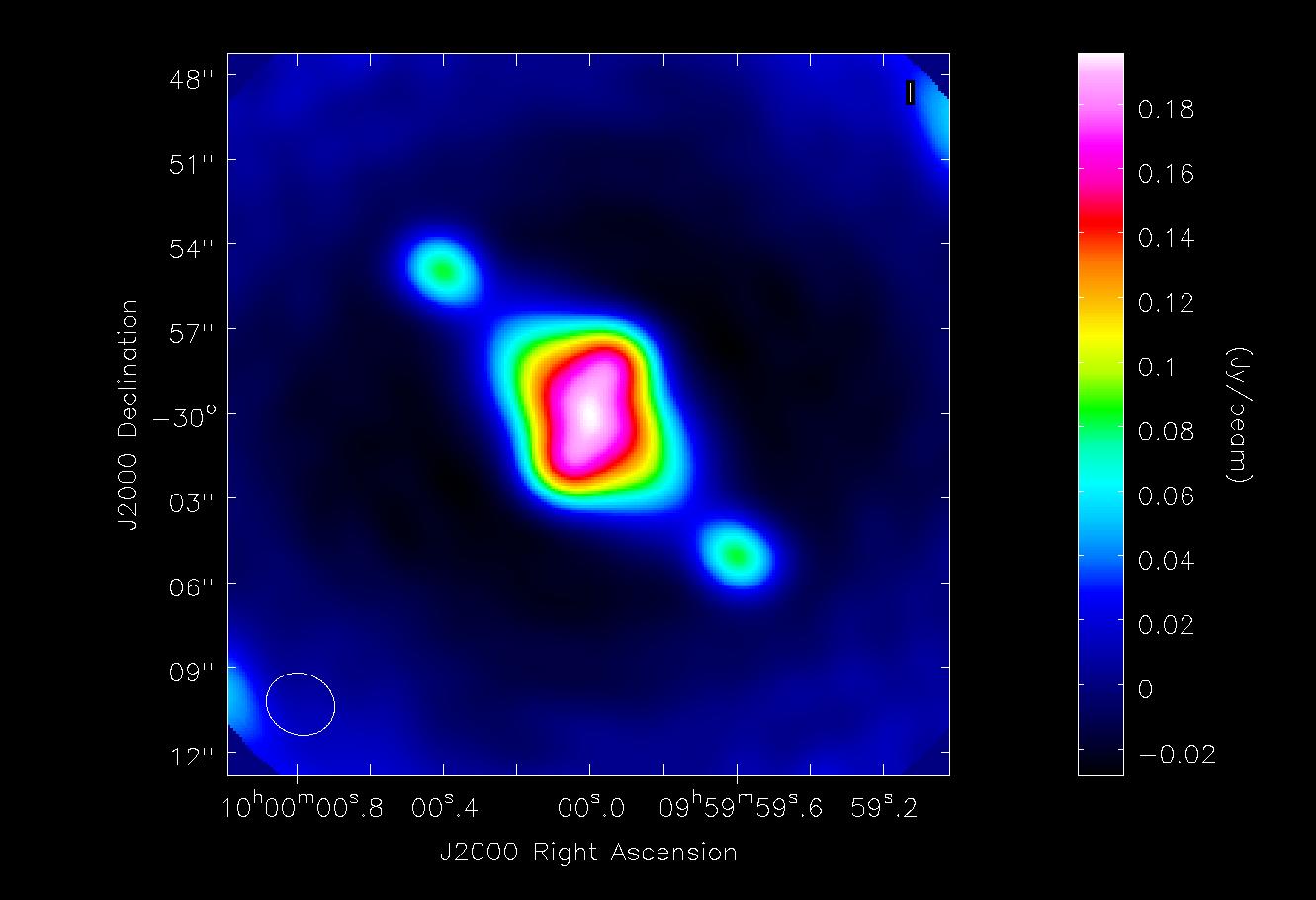
|
| Tutorial for simulating data based on multiple sources (using both a FITS image and a component list). If you are interested in simulating from a list of simple sources (point, Gaussian, disk), rather than or in addition to a sky model image, then read the considerations here. | |
| Einstein-Face (CASA 4.1) | 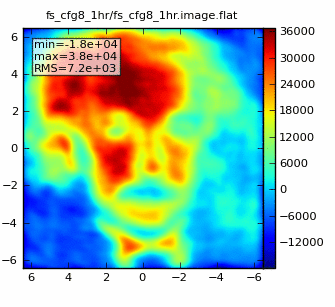
|
| A sky model and lightly annotated script that simulates the face of Einstein as seen by ALMA. This simulation is particularly useful for those who wish to better understand spatial filtering by an interferometer, but doesn't demonstrate new capabilities of the simulation tasks beyond those described above. | |
| ACA Simulation (CASA 4.1) | 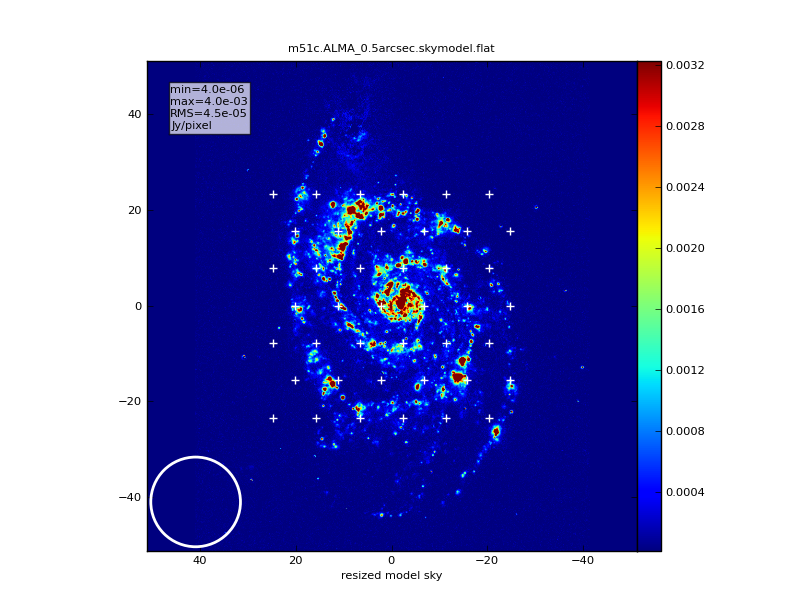
|
| A tutorial for simulating ALMA observations that use multiple configurations or use the
12-meter array in combination with the ALMA Compact Array. Of particular interest to those wishing to explore multi-component ALMA observations and their combination and e.g. whether the ACA improves your scientific fidelity. |
Example Input Images
Several examples of input model images are showcased here: Sim Inputs. These may be useful for running your own simulation tests, beyond what are presented in the above tutorials.
Advanced CASA Simulation
Under the Hood: The sm Tool
simobserve calls methods in the sm (simulation) tool. For advanced CASA users, the sm tool has methods that can add to simulated data: phase delay variations, gain fluctuations and drift, cross-polarization, and (coming soon) bandpass and pointing errors. sm also has more flexibility than simobserve in adding thermal noise. The tutorials linked from this page describe the simulation of data using the task interface only. To learn more about the sm tool, see the CASA Toolkit Reference Manual.
The sm tool can be used to corrupt your measurement set with thermal noise, phase noise, cross-polarization, etc., in a more advanced way than is done in simobserve. To learn advanced techniques for corrupting a simulated measurement set, see Corrupt.
Ephemeris and Geodesy
Generic ephemeris and geodesy calculations can be done using CASA Python module simutil.py.
Warning: CLEAN Bias
As is the case for real images, cleaning images produced by simobserve can lead to a spurious decrease in object fluxes and noise on the image (an effect known as "clean bias"). This is particularly true for observations with poor coverage of the uv-plane, i.e. using telescopes with small numbers of antennas, such as the ALMA Early Science configurations, and/or in short "snapshot" observations. Users should always clean images with care, using a small number of iterations and/or a conservative (3-5sigma) threshold and boxing bright sources.
User Feedback
We welcome input on developing the CASA simulator. Contact "rindebet at nrao.edu" if you would like to volunteer your input.